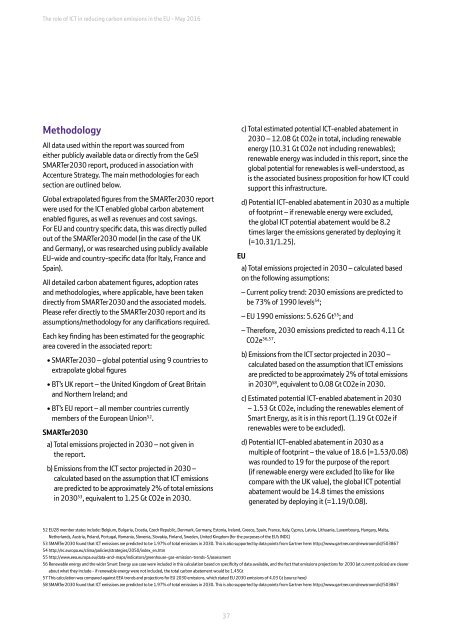The role of ICT in reducing carbon emissions in the EU
ICT_Carbon_Reduction_EU
ICT_Carbon_Reduction_EU
Create successful ePaper yourself
Turn your PDF publications into a flip-book with our unique Google optimized e-Paper software.
<strong>The</strong> <strong>role</strong> <strong>of</strong> <strong>ICT</strong> <strong>in</strong> reduc<strong>in</strong>g <strong>carbon</strong> <strong>emissions</strong> <strong>in</strong> <strong>the</strong> <strong>EU</strong> - May 2016<br />
Methodology<br />
All data used with<strong>in</strong> <strong>the</strong> report was sourced from<br />
ei<strong>the</strong>r publicly available data or directly from <strong>the</strong> GeSI<br />
SMARTer2030 report, produced <strong>in</strong> association with<br />
Accenture Strategy. <strong>The</strong> ma<strong>in</strong> methodologies for each<br />
section are outl<strong>in</strong>ed below.<br />
Global extrapolated figures from <strong>the</strong> SMARTer2030 report<br />
were used for <strong>the</strong> <strong>ICT</strong> enabled global <strong>carbon</strong> abatement<br />
enabled figures, as well as revenues and cost sav<strong>in</strong>gs.<br />
For <strong>EU</strong> and country specific data, this was directly pulled<br />
out <strong>of</strong> <strong>the</strong> SMARTer2030 model (<strong>in</strong> <strong>the</strong> case <strong>of</strong> <strong>the</strong> UK<br />
and Germany), or was researched us<strong>in</strong>g publicly available<br />
<strong>EU</strong>-wide and country-specific data (for Italy, France and<br />
Spa<strong>in</strong>).<br />
All detailed <strong>carbon</strong> abatement figures, adoption rates<br />
and methodologies, where applicable, have been taken<br />
directly from SMARTer2030 and <strong>the</strong> associated models.<br />
Please refer directly to <strong>the</strong> SMARTer2030 report and its<br />
assumptions/methodology for any clarifications required.<br />
Each key f<strong>in</strong>d<strong>in</strong>g has been estimated for <strong>the</strong> geographic<br />
area covered <strong>in</strong> <strong>the</strong> associated report:<br />
• SMARTer2030 – global potential us<strong>in</strong>g 9 countries to<br />
extrapolate global figures<br />
• BT’s UK report – <strong>the</strong> United K<strong>in</strong>gdom <strong>of</strong> Great Brita<strong>in</strong><br />
and Nor<strong>the</strong>rn Ireland; and<br />
• BT’s <strong>EU</strong> report – all member countries currently<br />
members <strong>of</strong> <strong>the</strong> European Union 52 .<br />
SMARTer2030<br />
a) Total <strong>emissions</strong> projected <strong>in</strong> 2030 – not given <strong>in</strong><br />
<strong>the</strong> report.<br />
b) Emissions from <strong>the</strong> <strong>ICT</strong> sector projected <strong>in</strong> 2030 –<br />
calculated based on <strong>the</strong> assumption that <strong>ICT</strong> <strong>emissions</strong><br />
are predicted to be approximately 2% <strong>of</strong> total <strong>emissions</strong><br />
<strong>in</strong> 2030 53 , equivalent to 1.25 Gt CO2e <strong>in</strong> 2030.<br />
c) Total estimated potential <strong>ICT</strong>-enabled abatement <strong>in</strong><br />
2030 – 12.08 Gt CO2e <strong>in</strong> total, <strong>in</strong>clud<strong>in</strong>g renewable<br />
energy (10.31 Gt CO2e not <strong>in</strong>clud<strong>in</strong>g renewables);<br />
renewable energy was <strong>in</strong>cluded <strong>in</strong> this report, s<strong>in</strong>ce <strong>the</strong><br />
global potential for renewables is well-understood, as<br />
is <strong>the</strong> associated bus<strong>in</strong>ess proposition for how <strong>ICT</strong> could<br />
support this <strong>in</strong>frastructure.<br />
d) Potential <strong>ICT</strong>-enabled abatement <strong>in</strong> 2030 as a multiple<br />
<strong>of</strong> footpr<strong>in</strong>t – if renewable energy were excluded,<br />
<strong>the</strong> global <strong>ICT</strong> potential abatement would be 8.2<br />
times larger <strong>the</strong> <strong>emissions</strong> generated by deploy<strong>in</strong>g it<br />
(=10.31/1.25).<br />
<strong>EU</strong><br />
a) Total <strong>emissions</strong> projected <strong>in</strong> 2030 – calculated based<br />
on <strong>the</strong> follow<strong>in</strong>g assumptions:<br />
– Current policy trend: 2030 <strong>emissions</strong> are predicted to<br />
be 73% <strong>of</strong> 1990 levels 54 ;<br />
– <strong>EU</strong> 1990 <strong>emissions</strong>: 5.626 Gt 55 ; and<br />
– <strong>The</strong>refore, 2030 <strong>emissions</strong> predicted to reach 4.11 Gt<br />
CO2e 56,57 .<br />
b) Emissions from <strong>the</strong> <strong>ICT</strong> sector projected <strong>in</strong> 2030 –<br />
calculated based on <strong>the</strong> assumption that <strong>ICT</strong> <strong>emissions</strong><br />
are predicted to be approximately 2% <strong>of</strong> total <strong>emissions</strong><br />
<strong>in</strong> 2030 58 , equivalent to 0.08 Gt CO2e <strong>in</strong> 2030.<br />
c) Estimated potential <strong>ICT</strong>-enabled abatement <strong>in</strong> 2030<br />
– 1.53 Gt CO2e, <strong>in</strong>clud<strong>in</strong>g <strong>the</strong> renewables element <strong>of</strong><br />
Smart Energy, as it is <strong>in</strong> this report (1.19 Gt CO2e if<br />
renewables were to be excluded).<br />
d) Potential <strong>ICT</strong>-enabled abatement <strong>in</strong> 2030 as a<br />
multiple <strong>of</strong> footpr<strong>in</strong>t – <strong>the</strong> value <strong>of</strong> 18.6 (=1.53/0.08)<br />
was rounded to 19 for <strong>the</strong> purpose <strong>of</strong> <strong>the</strong> report<br />
(if renewable energy were excluded (to like for like<br />
compare with <strong>the</strong> UK value), <strong>the</strong> global <strong>ICT</strong> potential<br />
abatement would be 14.8 times <strong>the</strong> <strong>emissions</strong><br />
generated by deploy<strong>in</strong>g it (=1.19/0.08).<br />
52 <strong>EU</strong>28 member states <strong>in</strong>clude: Belgium, Bulgaria, Croatia, Czech Republic, Denmark, Germany, Estonia, Ireland, Greece, Spa<strong>in</strong>, France, Italy, Cyprus, Latvia, Lithuania, Luxembourg, Hungary, Malta,<br />
Ne<strong>the</strong>rlands, Austria, Poland, Portugal, Romania, Slovenia, Slovakia, F<strong>in</strong>land, Sweden, United K<strong>in</strong>gdom (for <strong>the</strong> purposes <strong>of</strong> <strong>the</strong> <strong>EU</strong>’s INDC)<br />
53 SMARTer2030 found that <strong>ICT</strong> <strong>emissions</strong> are predicted to be 1.97% <strong>of</strong> total <strong>emissions</strong> <strong>in</strong> 2030. This is also supported by data po<strong>in</strong>ts from Gartner here: http://www.gartner.com/newsroom/id/503867<br />
54 http://ec.europa.eu/clima/policies/strategies/2050/<strong>in</strong>dex_en.htm<br />
55 http://www.eea.europa.eu/data-and-maps/<strong>in</strong>dicators/greenhouse-gas-emission-trends-5/assessment<br />
56 Renewable energy and <strong>the</strong> wider Smart Energy use case were <strong>in</strong>cluded <strong>in</strong> this calculation based on specificity <strong>of</strong> data available, and <strong>the</strong> fact that <strong>emissions</strong> projections for 2030 (at current policies) are clearer<br />
about what <strong>the</strong>y <strong>in</strong>clude - if renewable energy were not <strong>in</strong>cluded, <strong>the</strong> total <strong>carbon</strong> abatement would be 1.45Gt<br />
57 This calculation was compared aga<strong>in</strong>st EEA trends and projections for <strong>EU</strong> 2030 <strong>emissions</strong>, which stated <strong>EU</strong> 2030 <strong>emissions</strong> <strong>of</strong> 4.03 Gt (source here)<br />
58 SMARTer2030 found that <strong>ICT</strong> <strong>emissions</strong> are predicted to be 1.97% <strong>of</strong> total <strong>emissions</strong> <strong>in</strong> 2030. This is also supported by data po<strong>in</strong>ts from Gartner here: http://www.gartner.com/newsroom/id/503867<br />
37


